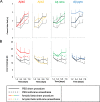Neurotoxicity of different amyloid beta subspecies in mice and their interaction with isoflurane anaesthesia
- PMID: 33270674
- PMCID: PMC7714346
- DOI: 10.1371/journal.pone.0242989
Neurotoxicity of different amyloid beta subspecies in mice and their interaction with isoflurane anaesthesia
Abstract
Background: The aim of this study was to assess different amyloid beta subspecies' effects on behaviour and cognition in mice and their interaction with isoflurane anaesthesia.
Methods: After governmental approval, cannulas were implanted in the lateral cerebral ventricle. After 14 days the mice were randomly intracerebroventricularly injected with Aβ 1-40 (Aβ40), Aβ 1-42 (Aβ42), 3NTyr10-Aβ (Aβ nitro), AβpE3-42 (Aβ pyro), or phosphate buffered saline. Four days after the injection, 30 mice (6 animals per subgroup) underwent general anaesthesia with isoflurane. A "sham" anaesthetic procedure was performed in another 30 mice (6 animals per subgroup, 10 subgroups in total). During the next eight consecutive days a blinded assessor evaluated behavioural and cognitive performance using the modified hole-board test. Following the testing we investigated 2 brains per subgroup for insoluble amyloid deposits using methoxy staining. We used western blotting in 4 brains per subgroup for analysis of tumour-necrosis factor alpha, caspase 3, glutamate receptors NR2B, and mGlu5. Data were analysed using general linear modelling and analysis of variance.
Results: Aβ pyro improved overall cognitive performance (p = 0.038). This cognitive improvement was reversed by isoflurane anaesthesia (p = 0.007), presumably mediated by decreased exploratory behaviour (p = 0.022 and p = 0.037). Injection of Aβ42 was associated with increased anxiety (p = 0.079). Explorative analysis on a limited number of brains did not reveal insoluble amyloid deposits or differences in the expression of tumour-necrosis factor alpha, NR2B, mGlu5, or caspase 3.
Conclusions: Testing cognitive performance after intracerebroventricular injection of different amyloid beta subspecies revealed that Aβ pyro might be less harmful, which was reversed by isoflurane anaesthesia. There is minor evidence for Aβ42-mediated neurotoxicity. Preliminary molecular analysis of biomarkers did not clarify pathophysiological mechanisms.
Conflict of interest statement
The authors have declared that no competing interests exist.
Figures




References
MeSH terms
Substances
LinkOut - more resources
Full Text Sources
Research Materials

